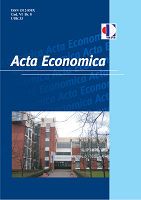СПОЉНА ТРГОВИНА ЗЕМАЉА У ТРАНЗИЦИЈИ ЦЕНТРАЛНЕ И ИСТОЧНЕ ЕВРОПЕ И СТРУКТУРНЕ ПРОМЕНЕ
FOREIGN TRADE IN THE COUNTRIES IN TRANSITION IN THE CENTRAL AND EAST EUROPE AND STRUCTURES OF CHANGING
Author(s): Radovan KovačevićSubject(s): National Economy, Supranational / Global Economy, Business Economy / Management, Economic policy, Political economy, Economic development, Socio-Economic Research
Published by: Економски факултет Универзитета у Бањој Луци
Keywords: Export; import; transition; capital;
Summary/Abstract: Central and East Europe Transition Economies (CIE) achieved favorable results in the field of foreign trade, parallel with programs of economy stabilization and privatization. According to foreign capital inflow, they succeeded in structural changes of production and increased export competitiveness. Clear consequence was growth of effiCIEncy in using of domestic resources. Regarding to regional aspects of foreign trade, EU became the main partner of these countries, above all thanks to growth of intra-industrial trade flows. Privatization was marked by introduction of labor in tensive production process, within transnational corporations have diminished production costs. Dynamic growth of intra-industrial trade almost is owing to growth of production characterized by low new added value. That makes export earnings vulnerable to cyclical oscillation of EU demand. All these countries are candidates for EU membership and in line with that, they signed so-called Europe an Agreement. That means free trade of industrial goods between them, except food-staffs. Croatia signed special agreement, which is different for some details regarding to Europe an Agreement. Russian Federation has the less liberalized system of trade with EU.
Journal: Acta Economica
- Issue Year: 2/2003
- Issue No: 1
- Page Range: 79-89
- Page Count: 11
- Language: Serbian

